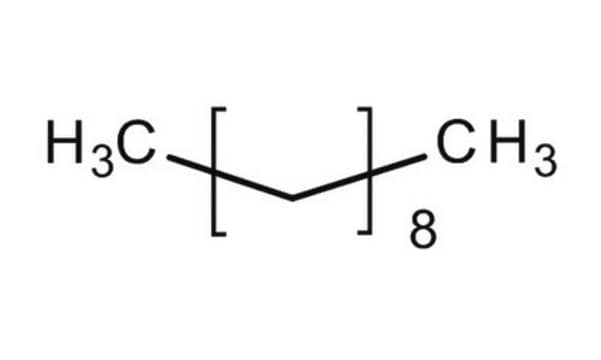8.03405
n-Decane
for synthesis
Sinónimos:
n-Decane
About This Item
Productos recomendados
vapor pressure
1 hPa ( 16 °C)
Quality Level
assay
≥99% (GC)
form
liquid
autoignition temp.
208 °C
potency
>5000 mg/kg LD50, oral (Rat)
>2000 mg/kg LD50, skin (Rat)
expl. lim.
0.7-5.4 % (v/v)
kinematic viscosity
<7 cSt(40 °C)
bp
174 °C/1013 mbar
mp
-30 °C
transition temp
flash point 51 °C
density
0.73 g/cm3 at 20 °C
storage temp.
2-30°C
InChI
1S/C10H22/c1-3-5-7-9-10-8-6-4-2/h3-10H2,1-2H3
InChI key
DIOQZVSQGTUSAI-UHFFFAOYSA-N
Application
- Molecular Dynamics in Surfactant Research: Dong et al. conducted molecular dynamics simulations to study the effects of surfactants on methane and n-decane interactions. This research provides insights into the applications of n-decane in enhancing the performance of surfactants in oil recovery and environmental remediation processes (Dong et al., 2024).
- Interfacial Adsorption Studies: Ruwoldt et al. explored the interfacial adsorption properties of oil-soluble kraft lignin and its ability to stabilize water-in-oil emulsions, where n-decane plays a crucial role as a model hydrocarbon solvent, contributing to understanding emulsion stability and lignin-solvent interactions in industrial applications (Ruwoldt et al., 2024).
- Semiconductor Strain Gauges in Geotechnical Engineering: Mikhaltsevitch and Lebedev utilized semiconductor strain gauges to measure the effective stress coefficient for the elastic moduli of sandstone. N-decane could potentially be used as a fluid medium in these experiments to simulate natural hydrocarbon environments, enhancing the accuracy of geophysical assessments (Mikhaltsevitch et al., 2024).
Analysis Note
Density (d 20 °C/ 4 °C): 0.729 - 0.730
Identity (IR): passes test
signalword
Danger
hcodes
Hazard Classifications
Asp. Tox. 1 - Flam. Liq. 3
supp_hazards
Storage Class
3 - Flammable liquids
wgk_germany
WGK 1
flash_point_f
114.8 °F - closed cup
flash_point_c
46.0 °C - closed cup
Certificados de análisis (COA)
Busque Certificados de análisis (COA) introduciendo el número de lote del producto. Los números de lote se encuentran en la etiqueta del producto después de las palabras «Lot» o «Batch»
¿Ya tiene este producto?
Encuentre la documentación para los productos que ha comprado recientemente en la Biblioteca de documentos.
Los clientes también vieron
Nuestro equipo de científicos tiene experiencia en todas las áreas de investigación: Ciencias de la vida, Ciencia de los materiales, Síntesis química, Cromatografía, Analítica y muchas otras.
Póngase en contacto con el Servicio técnico











